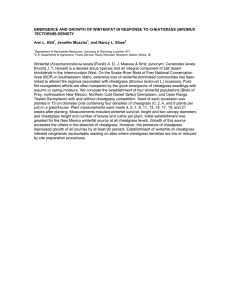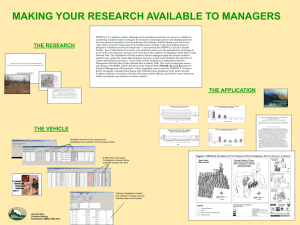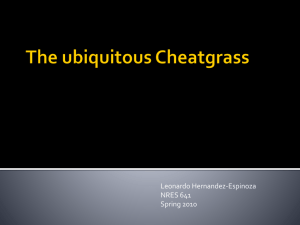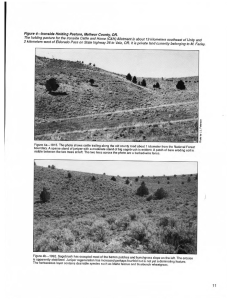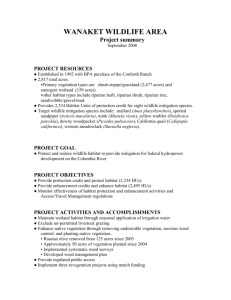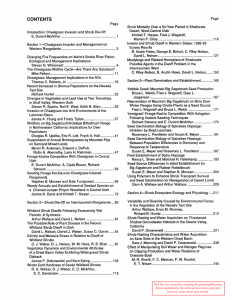CHEATGRASS: MANAGEMENT IMPLICATIONS IN THE 90'S Thomas C. Roberts, Jr. ABSTRACT
advertisement
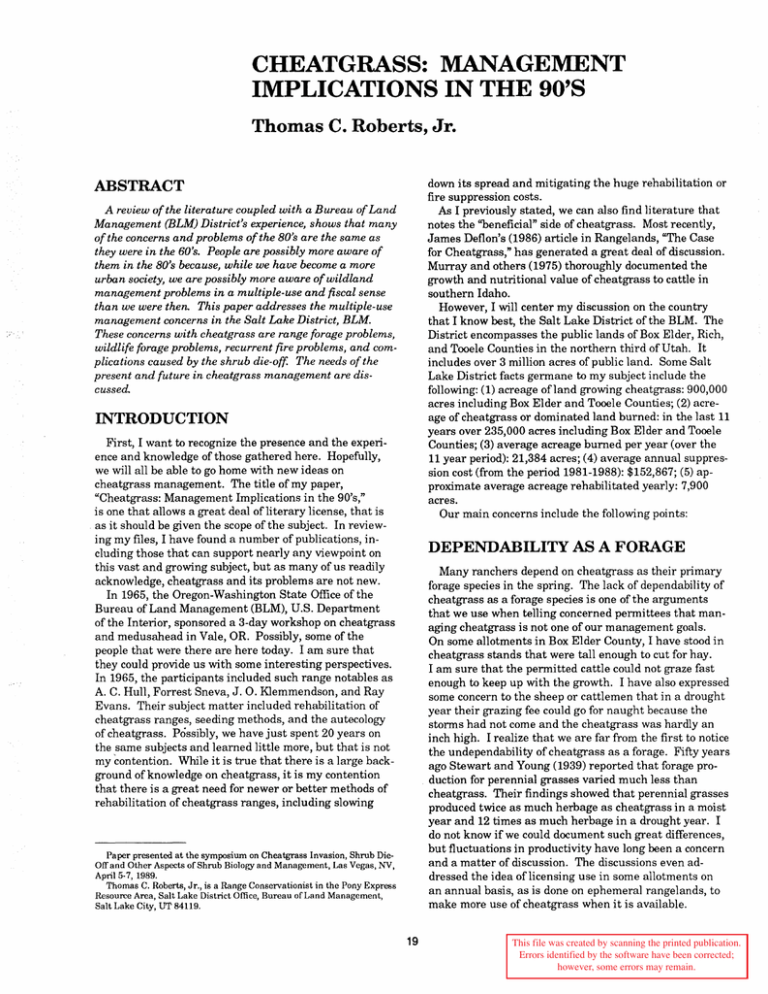
CHEATGRASS: MANAGEMENT IMPLICATIONS IN THE 90'S Thomas C. Roberts, Jr. down its spread and mitigating the huge rehabilitation or fire suppression costs. As I previously stated, we can also find literature that notes the "beneficial" side of cheatgrass. Most recently, James Deflon's (1986) article in Rangelands, "The Case for Cheatgrass," has generated a great deal of discussion. Murray and others (1975) thoroughly documented the growth and nutritional value of cheatgrass to cattle in southern Idaho. However, I will center my discussion on the country that I know best, the Salt Lake District of the BLM. The District encompasses the public lands of Box Elder, Rich, and Tooele Counties in the northern third of Utah. It includes over 3 million acres of public land. Some Salt Lake District facts germane to my subject include the following: (1) acreage ofland growing cheatgrass: 900,000 acres including Box Elder and Tooele Counties; (2) acreage of cheatgrass or dominated land burned: in the last 11 years over 235,000 acres including Box Elder and Tooele Counties; (3) average acreage burned per year (over the 11 year period): 21,384 acres; (4) average annual suppression cost (from the period 1981-1988): $152,867; (5) approximate average acreage rehabilitated yearly: 7,900 acres. Our main concerns include the following points: ABSTRACT A review of the literature coupled with a Bureau of Land Management (BLM) District's experience, shows that many of the concerns and problems of the 80's are the same as they were in the 60's. People are possibly more aware of them in the 80's because, while we have become a more urban society, we are possibly more aware of wildland management problems in a multiple-use and fiscal sense than we were then. This paper addresses the multiple-use management concerns in the Salt Lake District, BLM. These concerns with cheatgrass are range forage problems, wildlife forage problems, recurrent fire problems, and complications caused by the shrub die-off. The needs of the present and future in cheatgrass management are discussed. INTRODUCTION First, I want to recognize the presence and the experience and knowledge of those gathered here. Hopefully, we will all be able to go home with new ideas on cheatgrass management. The title ofmy paper, "Cheatgrass: Management Implications in the 90's," is one that allows a great deal ofliterary license, that is as it should be given the scope of the subject. In reviewing my files, I have found a number of publications, including those that can support nearly any viewpoint on this vast and growing subject, but as many of us readily acknowledge, cheatgrass and its problems are not new. In 1965, the Oregon-Washington State Office of the Bureau of Land Management (BLM), U.S. Department of the Interior, sponsored a 3-day workshop on cheatgrass and medusahead in Vale, OR. Possibly, some of the people that were there are here today. I am sure that they could provide us with some interesting perspectives. In 1965, the participants included such range notables as A. C. Hull, Forrest Sneva, J. 0. IGemmendson, and Ray Evans. Their subject matter included rehabilitation of cheatgrass ranges, seeding methods, and the autecology of cheatgrass. Possibly, we have just spent 20 years on the same subjects and learned little more, but that is not my contention. While it is true that there is a large background of knowledge on cheatgrass, it is my contention that there is a great need for newer or better methods of rehabilitation of cheatgrass ranges, including slowing DEPENDABILITY AS A FORAGE Many ranchers depend on cheatgrass as their primary forage species in the spring. The lack of dependability of cheatgrass as a forage species is one of the arguments that we use when telling concerned permittees that managing cheatgrass is not one of our management goals. On some allotments in Box Elder County, I have stood in cheatgrass stands that were tall enough to cut for hay. I am sure that the permitted cattle could not graze fast enough to keep up with the growth. I have also expressed some concern to the sheep or cattlemen that in a drought year their grazing fee could go for naught because the storms had not come and the cheatgrass was hardly an inch high. I realize that we are far from the first to notice the undependability of cheatgrass as a forage. Fifty years ago Stewart and Young (1939) reported that forage production for perennial grasses varied much less than cheatgrass. Their findings showed that perennial grasses produced twice as much herbage as cheatgrass in a moist year and 12 times as much herbage in a drought year. I do not know if we could document such great differences, but fluctuations in productivity have long been a concern and a matter of discussion. The discussions even addressed the idea oflicensing use in some allotments on an annual basis, as is done on ephemeral rangelands, to make more use of cheatgrass when it is available. Paper presented at the symposium on Cheatgrass Invasion, Shrub DieOff and Other Aspects of Shrub Biology and Management, Las Vegas, NV, April 5-7, 1989. Thomas C. Roberts, Jr., is a Range Conservationist in the Pony Express Resource Area, Salt Lake District Office, Bureau of Land Management, Salt Lake City, UT 84119. 19 This file was created by scanning the printed publication. Errors identified by the software have been corrected; however, some errors may remain. setting the stage for the other potential causes of the shrub die-off phenomenon? Because of the presence of cheatgrass, are shadscale, fourwing saltbush, and winterfat in a situation where water and nutrients are usurped by the cheatgrass, thus putting them in a precarious position ready for any other factor to push them over the edge? I am sure that the presence of cheatgrass makes the natural revegetation process more difficult. ECONOMICS Can we continue to fight rangeland and cheatgrass fires and rehabilitate them? The costs of rehabilitating after a cheatgrass fire, using an aggressive approach, can exceed $100 per acre. This includes seed, planting, protection fences, and contract administration. For example, the contract costs for the drilling of a project in Skull Valley was $26.00 per acre; the contractor supplied the equipment and operator. The seed cost was about $30.00 per acre. Although Siberian wheatgrass does not cost $5.00 per pound, it costs much more than the $.25 per pound that crested wheatgrass did many years ago. The protection fence for a rehabilitation project, although salvagable, can add $30 to $40 per acre to the project cost. No longer are land managers or users willing to accept a monoculture of crested wheatgrass, but diversity, even a little diversity, has its cost, which greatly increases the costs of the project. As you can see, rehabilitation after a rangeland fire can be very costly. Last year, our Area and District Manager were shocked when they saw the cost estimates for a cheatgrass fire rehabilitation project. The costs were higher than the appraised value on some nearby land that was recently sold. Are the costs of rehabilitating these lands going to influence our fire suppression behavior or our rehabilitation efforts? Maybe it is not a question of are they, but when are they going to modify our fire suppression behavior and rehabilitation efforts. Can we afford not to? DESERTIFICATION While I am not one to use buzz words, perhaps "desertification" fits in this situation. In some areas on our District, we could be left with two ecotypes, neither nativecheatgrass and juniper type. Fires, shrub die-off, and lack of regeneration, and the encroaching juniper type make the modern-day term of desertification fit. This is becoming a real problem, and cheatgrass domination could well be a step leading to desertification. IMPLICATIONS IN THE 90'S I entitled my paper "Cheatgrass Implications in the 90's," and so should address some of those implications if matters do not change: A Shortened Fire Cycle-This has already become a problem in some parts of the District: Skull Valley, for example. The problem of a shortened fire cycle is one that is well documented. In 1965, A. C. Hull felt safe in stating that a cheatgrass range is 10 to 500 times more likely to burn, and requires five times more men and equipment to control than fires on perennial grass ranges. He also believed that the cheatgrass fire season is from 1 to 3 months longer than the fire season on native rangelands. I do know that, although other factors may be involved, the fire season starts much earlier in Tooele County than it does in Rich County where there is not much cheatgrass. Simply put, the more cheatgrass, the more fire, more often. However, on a District level, the fire-suppression program is subject to the vagaries of policy shifts. We have been fortunate that the budget constraints for rehabilitation have been minimal. The fire cycle, imposed by a large acreage of cheatgrass, would probably not dovetail with the artificially imposed policy shifts. This would lead to an increase in acreage in cheatgrass and the ensuing problems. WILDLIFE IMPACTS Antelope forage and lagomorph forage are lost with concurrent losses to raptor habitat. This impact can be very important when the raptors are bald or golden eagles. Last year, the Utah National Guard hosted a live artillery firing exercise on BLM lands in the Salt Lake District. Some short-falling illumination rounds caused a 9,000-acre fire. One of the concerns in the environmental assessment was the amount of eagle (bald in the winter and golden year round) hunting that takes place in the area. The hunting takes place because of the rabbit population in the area. The loss of the desirable diversity in shrub and forb components of the vegetation composition has undoubtedly had a deleterious effect upon the rabbit and eagle habitat. The area (if our rehabilitation efforts are unsuccessful) is on its way to becoming a cheatgrass desert with a lack of botanical and faunal diversity, and this only addresses two of the affected animals and plants. Increased Susceptibility To Drought-Drought is a part oflife in the Intermountain West and native rangelands have evolved with it. Hopefully, the agricultural and managing agencies have learned to live with it, but, with cheatgrass in the picture, the model is complicated by the lack of forage carryover from a "normal" percipitation year to a drought year. The agencies and agricultural community manage on a sustained yield basis, not an ephemeral forage base. As previously stated, the presence of cheatgrass certainly complicates the managerial model. SHRUB DIE-OFF While this is a subject all its own, and cheatgrass has been around much longer than the recent die-off, I believe that the shrub die-off and cheatgrass are interrelated. Suffice to say, the shrub die-off is probably a result of any number of causes. Is the presence of cheatgrass and its opportunistic abilities in using water and nutrients 20 Improved Technology Transfer-This session and the rehabilitation workshop held by the Intermountain Research Station's Shrub Sciences Laboratory and Utah BLM were excellent. Often, the knowledge is received by a small percentage of those that need it. The atmosphere is improving, but many more mid- and upper-level personnel need to get the message. Cheatgrass is not, or should not be a range problem; it is a land management problem with concerns touching numerous disciplines. Lack of Diversity-As previously discussed, when the dominant aspect of a landscape is cheatgrass, the effect is a lack of botanical and faunal diversity, and a much less stable ecosystem. To anyone who picnics, camps, hunts, grazes livestock, or appreciates a native rangeland, the result is disheartening. There are more people seeking uses of public land who are expecting to find biological diversity, not a cheatgrass monoculture. Money-Because of the shortened fire cycle, as discribed above, money to maintain the system (trying to minimize the cheatgrass problem) becomes a deciding factor or certainly a limiting factor. Since it is expensive to fight the cheatgrass fires and rehabilitate the area, money becomes very important, and in tight budgetary times maybe not all that dependable. Increased Funding And Visibility-While high visibility would probably be ill-advised at the level of the Halogeton Control Program of the early 60's, land managers and the public need to be aware of the changes due to cheatgrass, and they will continue to take place without active intervention. Part of the increased visibility would, by design and necessity, be educational. People would realize the need for active intervention. In conclusion, I hope to see you at the next Cheatgrass Symposium in 20 years when the subject will be "Our Successes in the Rehabilitation of the Western Rangelands." Decreased Land Values-Although not a large factor in the managerial equation, the productivity of a grazing permit on cheatgrass acreage is probably worth less. At any rate, the capital stock of the land owner is depreciated, whether the land owner is private or public. REFERENCES MANAGEMENT NEEDS DeFlon, James G. 1986. The case for cheatgrass. Rangelands. 8: 14-17. Hull, A. C. 1965. Cheatgrass-a persistent homesteader. In: Proceedings, Symposium on management of cheatgrass on rangelands; 1965 July 27-30; Vale, OR. [Portland, OR]: U.S. Department of the Interior, Bureau of Land Management: 20-26. Murray, R. B.; Mayland, H. F.; Van Soest, P. J. 1978. Growth and nutritional value to cattle of grasses on cheatgrass range in southern Idaho. Res. Pap. INT-199. Ogden, UT: U.S. Department of Agriculture, Forest Service, Intermountain Forest and Range Experiment Station. 57 p. Stewart, G.; Young, A. E. 1939. The hazard of basing permanent grazing capacity on Bromus tectorum. American Society of Agronomy Journal. 31: 1002-1015. In closing I will address what I see as some needs of the management agencies. Less Expense-Less expensive methods and species to rehabilitate rangeland fires with more effective methods and means are needed. We are starting to branch out from the traditional crested wheatgrass areas and rangelands, and I expect that the seed prices will continue to follow the economic laws of supply and demand. We need the equipment and techniques to improve our success rates with native grasses and native and exotic shrubs and forbs, including, but not limited to, seed material that is suited to the equipment available. 21
